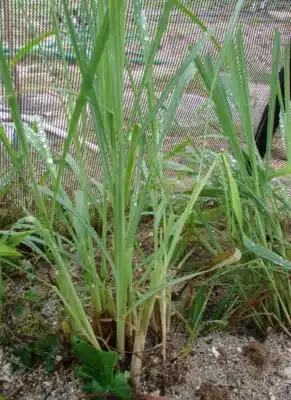Lemongrass Unveiled: Tracing Its Origins and Defining the Essence of Health, Nutrients with Uses and Benefits
Tamil it is known Karppurappul and Hindi it is known as Gandhatrina. Also known as Malabar or Cochin grass

Table of Contents
What is Lemongrass
Lemongrass, scientifically known as Cymbopogon citratus, is a perennial grass distinguished by its large flower spike. Native to southern India and Ceylon, this aromatic herb is extensively cultivated in tropical regions for its lemon-scented foliage. The plant serves a dual purpose, being valued both as a culinary seasoning and as the source of an aromatic essential oil.
Cultivated for its unique lemon flavor without the accompanying acidity, lemongrass has a fragrance that can surpass that of genuine citrus. Widely employed in Southeast Asian cooking, fresh cuttings are often prepared by separating the outer layers to expose tender young shoots in the center, which can then be finely chopped and incorporated directly into dishes.
Beyond its culinary applications, lemongrass finds extensive use in medicinal and industrial realms. The herb is a key ingredient in the production of citronella oil, a versatile substance utilized in soaps, insect repellents, and aromatherapy. This multi-faceted plant, with its rich aroma and distinctive flavor profile, continues to be a staple in various cultural and practical contexts.
Origin
Lemongrass (Cymbopogon citratus) is a fragrant, long-living plant in the grass family. It is native to Sri Lanka and South India but is now grown throughout Asia and tropical America. The plant is characterized by its tall, slender stalks and a distinct lemony aroma, which is attributed to the presence of citronella oil. In addition to its culinary uses, lemongrass is valued for its medicinal properties in traditional herbal practices. Its cultivation has expanded globally, making it a versatile and popular herb in various cuisines and herbal remedies worldwide.

Lemongrass Nutrients
Lemongrass, while not particularly rich in macronutrients, does contain several essential vitamins and minerals. Here is a general overview of the nutrients found in it:
Vitamins:
Vitamin C: It is a good source of vitamin C, an antioxidant that supports the immune system and helps the body absorb iron.
Vitamin A: Contributes to skin health and vision
Minerals:
Potassium: It helps to regulate blood and keeps the heart healthy
Magnesium: Muscles, nerves, and bones have a role to play.
Phosphorus: This helps a role of importance for your bone health and energy level.
Calcium: Essential for bone and teeth health.
Other Compounds:
Citronella Oil: It is known for its high citronella content, which gives it its distinctive aroma. Citronella oil is commonly used in various products such as insect repellents and aromatherapy.
Antioxidants:
It contains various antioxidants that help neutralize free radicals in the body, potentially reducing oxidative stress.
Phytochemicals:
It also contains compounds like citral, limonene, and myrcene, which contribute to its flavor, fragrance, and potential health benefits.
While it is more renowned for its culinary uses and aromatic qualities, its nutrient content adds a modest nutritional boost to dishes. It’s important to note that the exact nutrient composition can vary depending on factors such as the plant’s age, growing conditions, and preparation methods.

Lemongrass Health Benefits
Lemongrass offers various health benefits, thanks to its rich profile of antioxidants, vitamins, and other compounds. Here are some potential health benefits associated with lemongrass:
Antioxidant Properties: It contains antioxidants that help neutralize free radicals in the body. This may contribute to reducing oxidative stress, which is linked to various chronic diseases and aging.
Digestive Health: Traditionally, has been used to alleviate digestive issues. It may help in relieving indigestion, bloating, and constipation. The herb is believed to have carminative properties, which can aid in the expulsion of gas from the digestive system.
Anti-Inflammatory Effects: Some components in grass, such as citral, exhibit anti-inflammatory properties. This may be beneficial in reducing inflammation in the body, which is associated with various health conditions.
Immune System Support: The presence of vitamin C contributes to immune system function. Vitamin C is essential for the production and function of white blood cells, which play a crucial role in the body’s defense against infections.
Cholesterol Management: Preliminary studies suggest that lemongrass may have a positive impact on cholesterol levels. It is believed to help lower levels of LDL (bad) cholesterol while increasing HDL (good) cholesterol.
Antimicrobial Properties: It has been traditionally used for its antimicrobial properties. It may help combat certain bacteria and fungi, contributing to overall oral and skin health.
Stress and Anxiety Reduction: The Aroma is often used in aromatherapy for its calming and stress-relieving effects. Inhaling the scent may help reduce anxiety and promote relaxation.
Potential Cancer-Fighting Properties: * Some studies suggest that it contains compounds with potential anticancer properties. However, more research is needed to establish its efficacy in preventing or treating cancer.
It’s important to note that while it can be a flavorful addition to a balanced diet, and it has been traditionally used for various health purposes, individual responses may vary. As with any herbal remedy, it’s advisable to consult with a healthcare professional before incorporating large quantities of lemongrass into your diet, especially if you have any existing health conditions or are taking medications.
Lemongrass Recipe
Making lemongrass tea is a simple and delightful process. Here’s a basic recipe to guide you:
Ingredients:
Fresh lemongrass stalks (2-3 stalks)
Water (5 cups)
Optional: Honey (for cold tea), Organic Jaggery, Ginger, or Mint for added flavor.
Instructions:
Prepare the Lemongrass:
Rinse the stalks thoroughly to remove any dirt or debris.
Trim off the root end and any dry or woody leaves.
Bruise the Lemongrass: Using a rolling pin or the back of a knife, gently bruise the stalks. This helps release the flavorful oils.
Cut into Pieces: Cut the grass from the bottom into small pieces about ½”. As per cup tea add 4 to 5 pieces per cup.This allows for better infusion of the flavors.
Boil the Water: If you are making a cup of tea you should add 1 ½ cup of water to boil and let it simmer till a cup is balance. In a pot, bring 5 cups of water to a boil.
Add Lemongrass: Once the water is boiling, add the grass pieces to the pot.
Simmer: Reduce the heat to low and let the lemongrass simmer till it reduces to 3 cups or so, this allows the flavors to infuse into the water.
Strain: After simmering, strain the grass pieces from the tea using a fine mesh strainer or a tea infuser.
Serve: Hot lemongrass tea, pour into cups, and add Organic Jaggery as per taste enjoy ( Do not use Honey in any hot liquids), ginger, or mint for additional flavor.
Optional Variations: For a sweeter tea, add honey or your preferred sweetener.
Enhance the flavor by adding a slice of ginger or a few fresh mint leaves.
Iced Lemongrass Tea (Optional): If you want to enjoy cold tea, refrigerate it and serve it over ice for a refreshing iced grass tea cut the green the top of the lemongrass and add it on top, just a finishing touch.
Lemongrass tea can be enjoyed hot or cold, and it’s known for its calming and refreshing properties. Feel free to adjust the quantities and ingredients based on your taste preferences.
